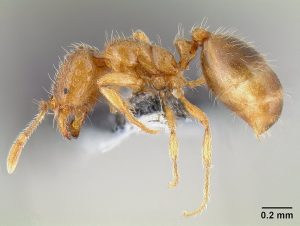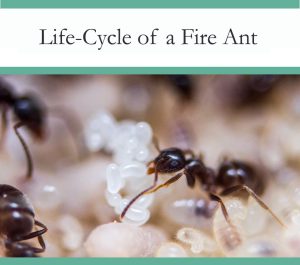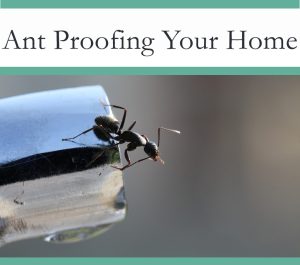Ladybugs and Other Organic Pest Control
October 23rd 2019, by Dan Crosfield

There’s more to pest control than toxic chemicals. In recent years, more and more people have started looking for more natural methods of getting rid of bugs. Fortunately, if you’re looking to reduce your own use of potentially harmful chemicals, there are a lot of ways to switch to organic pest control and take the environmentally friendly approach to control ants, pests and bugs. Depending on the pest issue you’re dealing with, you can try the following methods outlined below in this guide.
Environmental Controls
Pest problems don’t occur for no reason. If you’re dealing with a species, no matter what it is, it’s because the creature has found an environment that suits it. Maybe that’s a colony of ants inside your home, or perhaps it’s a plague of other insects outside in your yard. But whatever the case may be, you can often solve the problem just by altering the environment.
For example, fleas require high humidity to thrive – at least 50%. Using a dehumidifier to lower the relative humidity in your home can make it impossible for the insects to survive. The advantage of this method is that it requires no pesticides to be used but simply exploits a weakness in the biology of the animals you’re trying to control.

Likewise, all creatures need to eat and drink. If you have cockroaches, ants, or mice in your home, you know that they are getting a food source from somewhere. Cockroaches, in particular, will stay inside your house if possible, finding all they need to eat and drink in your kitchen. So a thorough cleaning of your kitchen can remove the food source that is allowing these bugs to thrive. A clean house is far less attractive to several pest species.
Sometimes, cleaning and storing food properly can solve a problem all by itself. For instance, stored product pests such as Indian meal moths and grain beetles live most of their lifecycle inside a food source. Find the dry food that they are consuming and get rid of it, and you may solve the problem right there.
A thorough cleaning can remove food sources
When dealing with outdoor pests, controlling the environment is trickier, but still worth exploring. If your yard is overrun by ants, consider what they may be eating. Perhaps by dealing with the population of aphids on your plants, you will bring the ant population down to a more manageable level. Also, areas of wet soil or woodpiles against the house can provide a perfect habitat for ants. Dealing with these areas gives the creatures one less place to live, and makes it far less likely that you will have to deal with the problem in the future. The same goes for mammals such as mice and rats. If there’s nothing to eat and nowhere to hide in your yard, you are unlikely ever to have a problem with these creatures.
Biological Pest Controls
When it comes to natural pest control, the enemy of your enemy may well be your friend. Everything in nature is part of a balance, a delicate relationship between predator and prey. Many of the pest species that invade our homes and gardens have natural predators that can help keep their numbers in check.
Ladybugs will help reducing aphid damage
If you’re suffering from aphid damage to your plants, you may wish to encourage ladybugs by planting heavy pollen producing plants like sunflowers but be wary of buying ladybugs as they may introduce parasites. Ladybugs will eat about 5000 aphids and other insect egg’s in its life of two to three years. Not only will this prevent damage to your plants, but aphids provide a major food source for ants. Reducing the aphid population will naturally reduce the ant population, too.

If you’re plagued during the summer months by mosquitoes, consider building a bat house on your property. Bats are fearsome predators of mosquitoes, and while they won’t get rid of the flying parasites completely, they will bring their numbers down to a far more comfortable level.
Another example of biological pest control is nematodes. These are tiny parasitic worms that prey on certain species of bugs, including beetles the can often do damage to lawns. Nematodes only target specific species of bugs and leave everything else alone. So unlike a chemical pesticide, spraying nematodes on your lawn will not affect local bees, butterflies, or other beneficial insects.
As for mice and rats, make friends with local cats. Cats were first domesticated because of their instinctive drive to hunt and kill mice and other small pests. Sometimes, even the smell of a cat is enough to keep rodents away. If you don’t have a cat of your own, see if you can borrow one from a neighbor or friend. Give a mouse a choice between a home that is patrolled by a cat and another that isn’t, and it will choose the cat-free home every single time.
Spraying nematodes will not affect local bees, butterflies, or other beneficial insects.

Trapping
Sometimes, old-fashioned methods are the best. Ant traps usually contain chemicals, but not all traps rely on toxic chemicals and work instead by catching and killing unwanted animals directly.
The classic example is the old-fashioned mousetrap. Not everyone is comfortable with dealing with these gadgets, but they can be very useful in controlling an infestation. Spring-loaded snap traps are more humane than you might think, usually killing mice and rats instantly. You’ll need to use multiple traps and carefully consider where you set them up to ensure the best chance of success. But often, a rodent problem can be solved with trapping alone, with no need to resort to any chemical solutions.
Other pests are also susceptible to trapping. Indian meal moths can be lured into traps by synthetic hormones that mimic the pheromones these creatures used to find one another. By trapping all the males in a population, pheromone traps can help to break the reproductive cycle of bugs. Light traps can do the same for flies. And for kitchen invaders like fruit flies, you can make your own traps from a dish of vinegar covered with plastic wrap with a few holes poked in it. These traps may not always be enough to solve a bug problem by themselves. But they can keep the population in check and, combined with rigorous cleaning and removal of all food sources, can be surprisingly effective in dealing with bugs.
When trapping, though, it’s essential to understand something about the biology of the pest you’re dealing with. Some species can be completely eradicated by the use of traps alone. Others can be kept under control by traps until you find another method to get rid of them totally. A third group of species can never be gotten rid of by trapping alone. These include the bugs with the highest reproductive rates, such as bedbugs, cockroaches, and fleas. These insects will outbreed your attempts to trap them. Traps are only used with these species to monitor for their presence.

Physical Barriers
Even though it may sometimes seem otherwise, no animal exists solely to be a pest to humans. Everything has a place in the natural world. It’s just that human habitats and ways of living have allowed certain creatures to spread and proliferate beyond what they would otherwise have achieved. In many ways, the problem isn’t with pests. It’s with us.
A pest isn’t really a pest if it can’t get into areas you don’t want. By keeping animals outside of your home, you can live alongside them without conflict. For instance, squirrels usually seem like a relatively benign species. They are even cute. But if they build a nest inside your attic, you’ll quickly stop feeling any kind of warmth toward these bushy-tailed invaders. You can prevent this from happening by taking a good look around your home, especially at the roofline. Gaps in the roof allow squirrels and rats to get inside, where they make a nuisance of themselves and can even cause damage to your home. You don’t need to kill these animals or harm them in any way; all you need to do is keep them outside where they are supposed to be. Sealing up any holes you find with quarter-inch galvanized steel mesh will keep them out of your home and remove any source of conflict.
Squirrels can be cute. But if they build a nest inside your attic, they will quickly become a pest
The same is true of birds such as pigeons, sparrows, and starlings. These birds will happily make homes in or on buildings if they can find a way inside. But if you can keep them out using nets or screens, you won’t have a problem with them.
The smaller the pest, the harder it can be to keep outside. But blocking up holes in walls, particularly around pipes and air vents, can go a long way toward keeping out mice and even smaller pests such as ants. Weatherproof silicone caulk is the perfect thing to block up small holes, whereas larger gaps may need more extensive repairs. For more details on ant proofing your home, see our guide.

Naturally Occurring Pesticides
When trapping and environmental controls aren’t enough, there are other options available. Not all pesticides are made in a lab, and not all are harmful to human health. Some naturally occurring substances can help you deal with an infestation safely and organically.
One of the most widely used is Diatomaceous Earth. This product comes as a fine white powder that feels soft to the touch. But on a microscopic level, it’s all jagged edges and sharp fragments. Diatomaceous Earth is made from the bodies of diatoms, tiny aquatic animals whose cell walls are made of a kind of naturally occurring glass. To us, these fragments are far too tiny to be harmful. But to insects, diatomaceous earth can be deadly. By lacerating the exoskeleton of a bug that comes into contact with it, Diatomaceous Earth causes insects to dehydrate and die.
Food grade Diatomaceous Earth is safe to use throughout your home, including in kitchens. For that matter, it’s even safe to eat.
Another naturally occurring mineral that works well as a pesticide is Borax. This substance is usually used as a laundry booster but is also a potent stomach poison for creatures such as ants. Mixing Borax with powdered sugar creates a bait that ants will happily consume and carry back to the nest, where it will slowly kill them. Although it’s not recommended that you eat Borax yourself, having it around the home won’t do any harm to you or to your pets. Looking for other natural treatments specifically for ants? Check out our guide.

Targeted Pesticides
As the pest control industry has moved away from old-fashioned toxic sprays, new pesticides have been developed that are far more targeted in their approach. These have quickly become the first choice of pest control operators, since the ability to target a single species dramatically reduces the risk of harm to nontarget organisms and the environment in general.
A good example of a targeted pesticide is the bait used to control cockroaches. Instead of spraying, which can often make the problem worse by causing cockroaches to scatter, bait attracts the bugs and encourages them to eat it. The cockroaches absorb the poison and even spread it to one another. Slowly but surely, the poison makes its way through the entire population and kills the cockroaches off. These baits are far more effective than sprays at dealing with cockroaches, and they also have the advantage of not being toxic to humans or any other mammals. And because the bait is specially formulated to appeal to cockroaches, most other insects won’t go anywhere near it. The baits work on cockroaches and only on cockroaches, making them some of the safest and least environmentally harmful pesticides to use.
Another class of sophisticated organic pesticides is the insect growth regulators or IGRs. These products disrupt an insect’s natural hormonal balance that allows its body to grow and develop effectively. These chemicals can sterilize bugs and prevent juveniles from growing into adulthood. By breaking the reproductive cycle of bugs, this class of chemicals can bring a bug problem to a complete halt. And because the hormones that allow a bug to grow and develop are so specific to the individual species, these chemicals are also incredibly targeted. Usually, they only affect the exact species they were designed for, and are completely harmless to anything else. Certainly, they are totally harmless to non-insect species, including humans.

Why Go Organic?
There was a time, not too long ago, when the standard response to a pest problem was the use of a chemical. This was especially true when it came to insects and other bugs. In the not-so-good old days, pest control revolved around chemical extermination, and the prevailing doctrine was that the stronger the chemical you could use, the better.
But things have changed. The banning of the widely used pesticide DDT in 1972 in the US and around the world in 2001 was a major turning point. Although this chemical was highly effective at killing mosquitoes, bedbugs, and other creatures, the damage wasn’t limited to these target organisms. The chemical had a long and destructive life in the environment, causing tremendous harm to wildlife and even people.
These days, people are more concerned than ever about their health. We know more than our grandparents did about the effects of pesticides and other toxic chemicals on our environment and our health. And as species continue to go extinct at an alarming rate around the world, we need to reevaluate our use of chemical pesticides.
Also, thanks to the high breeding rate and lifecyle of most pest species, chemicals that worked 20 or 30 years ago may no longer work today. Insects develop resistance to chemicals that are commonly used against them, and if this resistance isn’t managed, chemical solutions can end up being useless. So there are reasons to look at other methods of pest control beyond the environmental. If we want methods that will work in the long term, we need to look at more organic and natural methods of control.
Organic Pest Control; The End of Pesticides?

While we’re all working toward lowering our usage of potentially harmful chemicals, pesticides are still very much with us. Ultimately, they are a tool, and like any tool, they aren’t inherently good or bad in themselves. It’s all in the way you use them. Sometimes, greater harm can come from not using pesticides when you should. Part of the reason the human population of the planet is higher now than at any other time in history is because of the increasing sophistication of pesticides that has allowed us to grow more food in less space than was ever possible before. And given that mosquitoes are one of the most dangerous animals on earth, thanks to the diseases they carry, it’s clear that pesticides are still very much needed to protect human health.
However, chemical pesticides are best thought of as a last resort. The more readily we use them, the less effective they will become over time. So wherever possible, it’s a good idea to find more natural pest control solutions.
Luckily, these natural solutions are readily available. They may require a little more work in terms of learning more about the biology of the pest involved. After all, screening around your home or changing the environment in your yard is a tougher process than merely spraying a chemical. But in the long run, it’s worth it. Reducing pesticide use can lead to a healthier planet and healthier people.
Additionally, nonpesticide treatments are often more effective at dealing with pests in the long term. After all, you can keep killing mice all day long, but as long as more can get inside your home, you’ll always have a problem. Block up the hole they’re using, though, and you may never have to do it again.
So if you have a pest problem, before reaching for that can of spray, consider some of the organic pest control options listed above. The chances are good that you can solve your pest problem without the use of any toxic chemicals.


